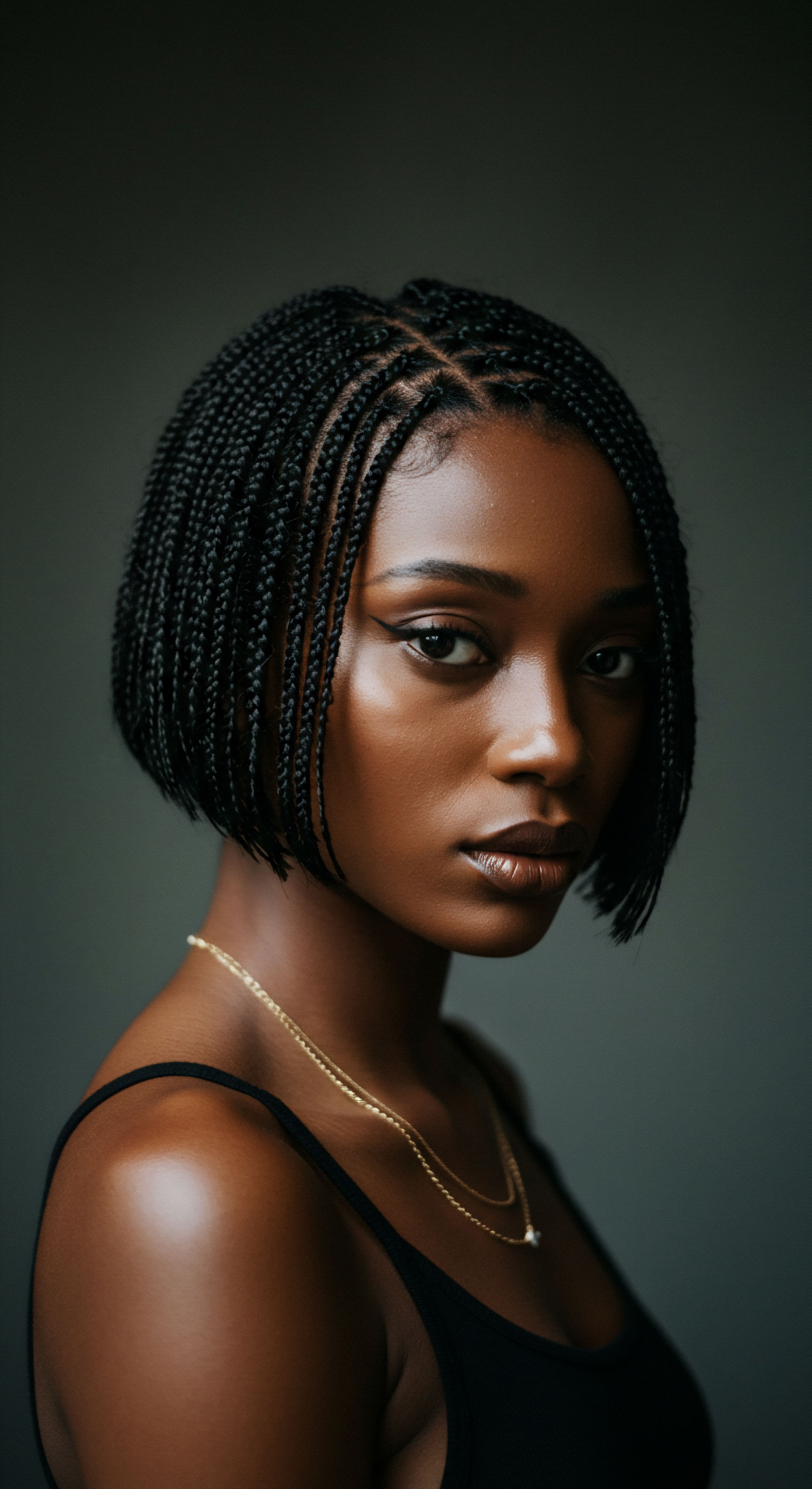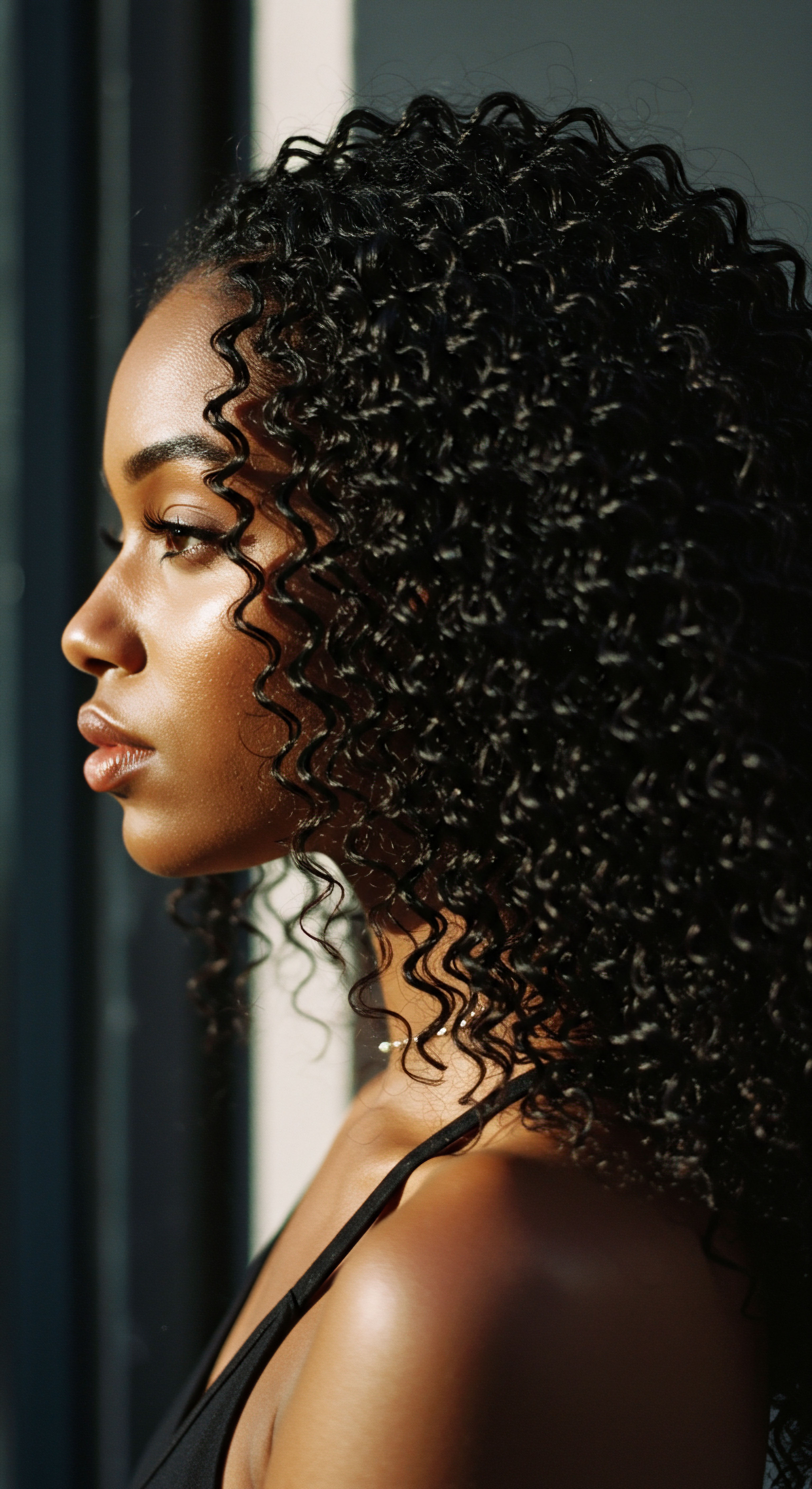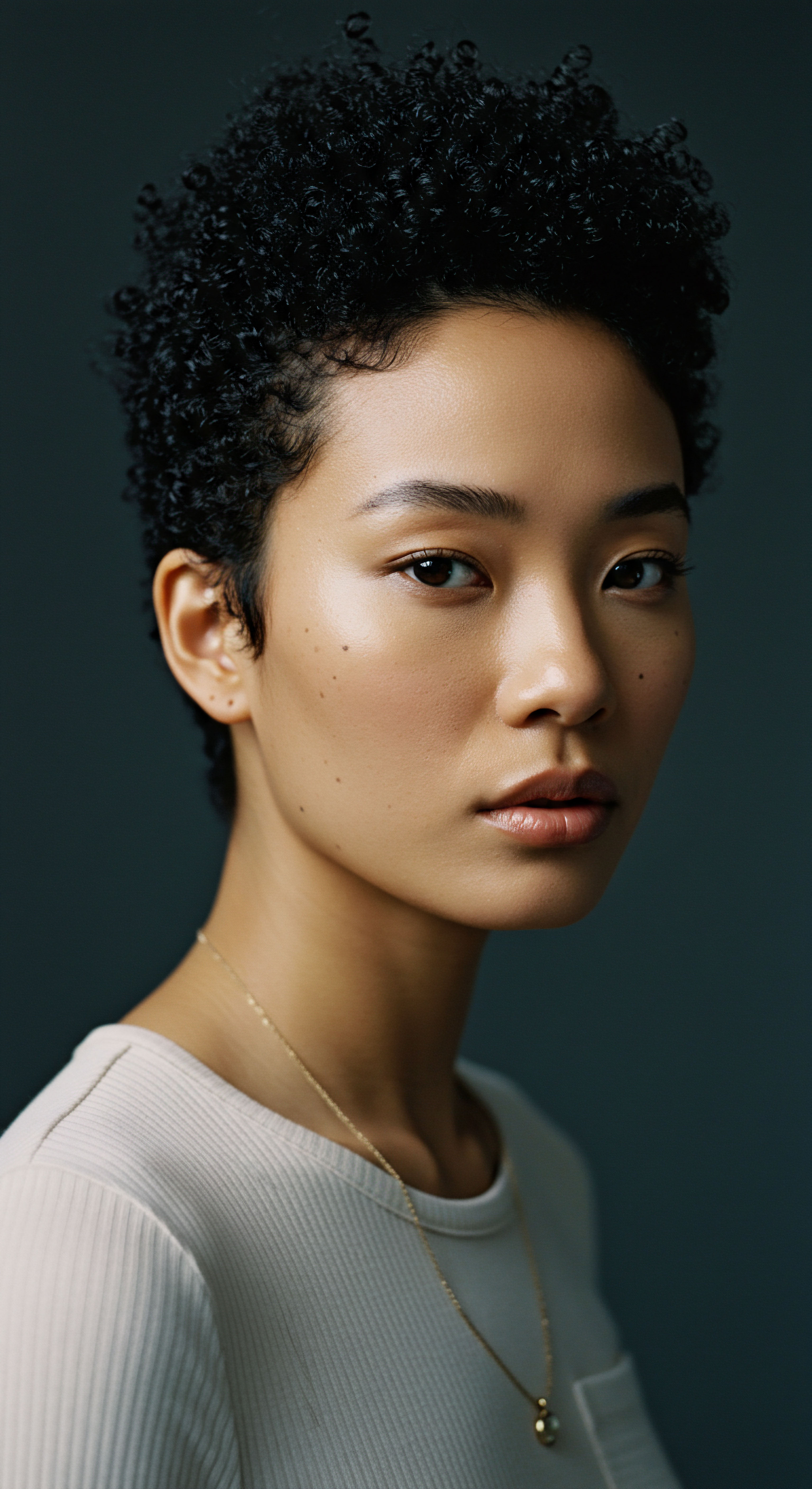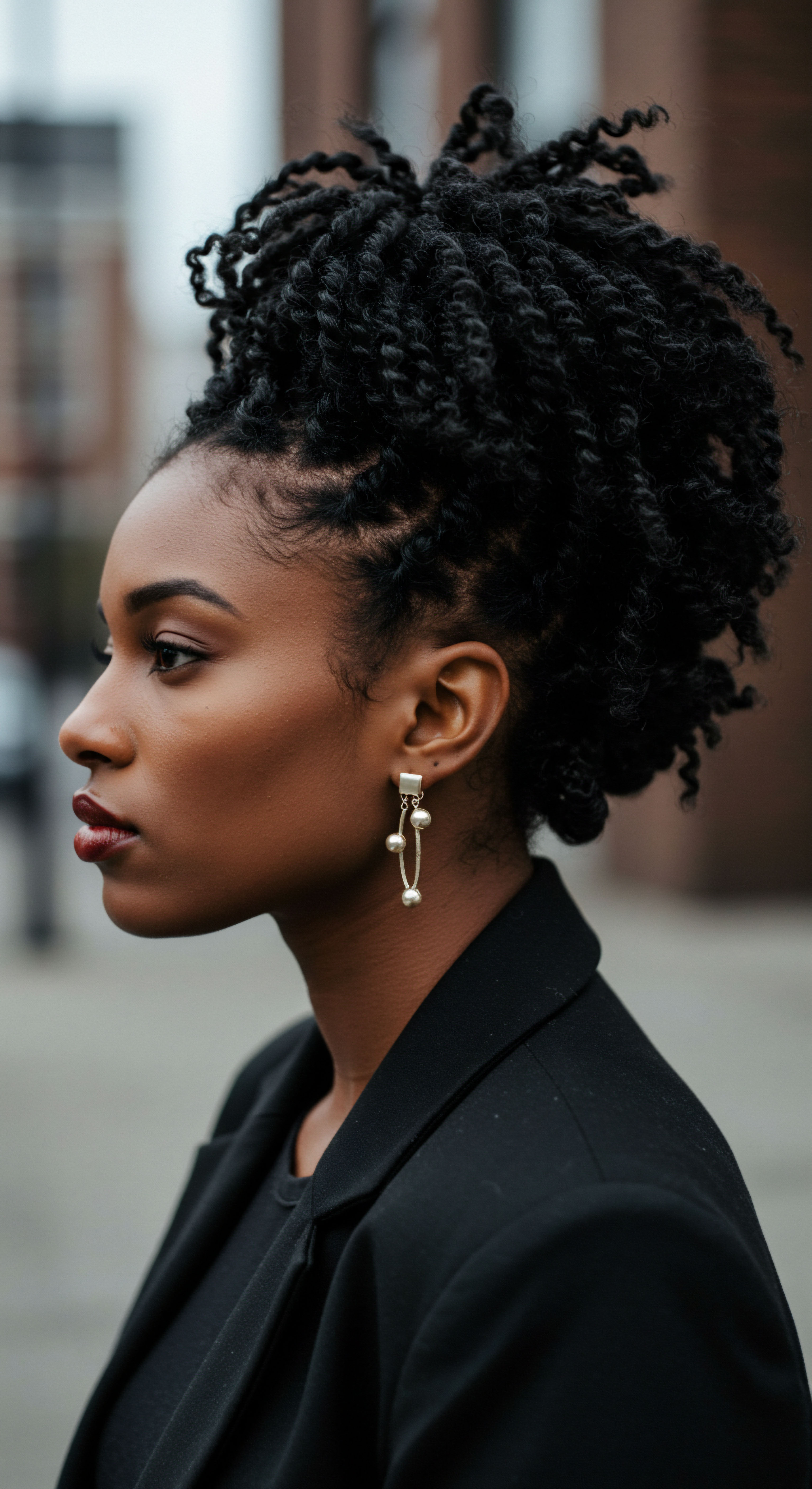
Roots
Consider for a moment the quiet intimacy of tending to one’s hair, a practice as old as humanity itself. Across cultures and epochs, the strands that crown us have held a silent, profound power, serving as more than just a biological covering. They have been canvases for expression, banners of belonging, and often, intricate maps of one’s place within the societal order.
In the sun-drenched lands of ancient Egypt, a civilization renowned for its meticulous artistry and complex social structures, hair was no exception. It was not merely a matter of personal preference; the styles worn, the materials employed, and the very presentation of one’s coiffure spoke volumes, whispering secrets of status, occupation, and even spiritual connection.
To truly grasp the significance of ancient Egyptian hairstyles, one must first look beneath the surface, past the gleaming depictions on tomb walls, and into the very essence of their daily lives. The Nile’s fertile banks nurtured a society deeply stratified, where each individual occupied a distinct position, from the pharaoh at the apex to the laborers toiling in the fields. This hierarchical arrangement permeated every facet of existence, and the care and display of hair became a tangible indicator, a visual shorthand that communicated one’s standing without a single word needing to be uttered. The natural hair textures of the populace, ranging from tightly coiled to wavy, presented a foundation upon which elaborate styles were constructed, often involving wigs, extensions, and a remarkable array of cosmetic products.

Hair as a Mark of Cleanliness and Health
Beyond social indicators, the Egyptians held cleanliness in exceptionally high regard, a principle extending to their hair and scalp. Maintaining a pristine appearance was tied to both health and piety. Lice and other parasites were a constant concern in the warm climate, prompting widespread practices of shaving heads, particularly among the elite and priests. The smooth scalp, free from the potential for infestation, became a sign of purity and dedication.
This shaved state often served as the foundation for wearing wigs, which were not only decorative but also practical, offering protection from the sun and a means of personal hygiene. The meticulous care of these wigs, often made from human hair or plant fibers, further underscored the owner’s resources and attention to detail.

Did Hair Length and Volume Always Signify Wealth?
It is tempting to conclude that greater hair length or volume directly equated to higher social standing. While often true, the reality was more nuanced. For instance, the very short or shaved styles seen on priests and priestesses were not indicative of low status; quite the opposite. These looks signified a dedication to religious purity and a separation from worldly concerns.
For the general populace, however, the ability to maintain longer, more elaborate natural hair or to afford well-crafted wigs did generally align with prosperity. Laborers and those of lower means often kept their hair shorter or in simpler, more practical styles, minimizing the time and resources required for upkeep. The material composition of wigs also varied significantly; those crafted from real human hair were a luxury, while cheaper alternatives used plant fibers or even wool.
Ancient Egyptian hairstyles transcended mere adornment, serving as a silent language of social standing, cleanliness, and even spiritual dedication.
The meticulous attention to hair, whether natural or artificial, speaks to a deeply ingrained cultural understanding of appearance as a reflection of one’s inner and outer world. This foundational understanding sets the stage for exploring the specific practices and cultural rituals that further solidified hair’s role in the intricate tapestry of ancient Egyptian society.

Ritual
Moving from the foundational principles of ancient Egyptian hair culture, we now step into the realm of daily practice and the intricate rituals that shaped its expression. The application of oils, the styling of wigs, and the adornment with jewels were not haphazard acts but rather deliberate, often time-consuming ceremonies that underscored the wearer’s position and identity. These rituals were not just about appearance; they were about maintaining a desired image, performing one’s social role, and participating in the broader cultural dialogue of the Nile Valley. The preparation of hair, whether natural or wigged, was a testament to the resources available and the societal expectations placed upon individuals.

The Wig as a Social Statement
Wigs were perhaps the most potent symbol of social standing in ancient Egypt. Their prevalence spanned millennia, evolving in style and complexity. For the elite, wigs were indispensable, worn by both men and women.
They served multiple purposes ❉ protection from the sun, a display of wealth, and a symbol of hygiene. The quality of a wig—its material, craftsmanship, and intricacy of style—directly corresponded to the wearer’s status.
- Human Hair Wigs ❉ These were the most luxurious, often imported or sourced from slaves, and meticulously styled. They were typically worn by the pharaoh, nobility, and high-ranking officials.
- Plant Fiber Wigs ❉ Less costly, these were made from materials like palm fiber or vegetable fibers, often dyed and styled to mimic more expensive human hair wigs. They were common among the middle classes.
- Wool or Animal Hair Wigs ❉ The most economical option, these were worn by those of lower economic standing or for specific purposes, such as theatrical performances or religious rituals.
The very act of commissioning, acquiring, and maintaining such an accessory spoke volumes. A well-kept, elaborate wig required not only initial expense but also ongoing care, often performed by servants or skilled wigmakers. This demonstrated leisure and access to labor, privileges reserved for the upper echelons of society.

What Role Did Cosmetics Play in Hair Presentation?
The Egyptians were masters of cosmetics, and their application extended to hair. Rich oils, often scented with myrrh or frankincense, were applied to both natural hair and wigs, providing shine and a pleasant aroma. These unguents also served practical purposes, conditioning the hair and protecting the scalp. Henna, a natural dye, was widely used to color hair and wigs, particularly to achieve a reddish-brown hue.
For the elite, the quality and exoticism of these ingredients were yet another subtle indicator of their position. For example, a 2011 study by Joann Fletcher and her team, examining hair samples from mummies, found evidence of complex styling techniques and the extensive use of fatty acids and resin for conditioning and holding styles, suggesting a sophisticated understanding of hair care chemistry. This empirical data confirms the elaborate nature of their hair rituals.
The ritual of preparing one’s hair or wig involved a suite of tools ❉ combs made of wood or ivory, pins, and mirrors of polished copper or bronze. The very possession of these items, particularly those crafted from precious materials, reflected the owner’s prosperity. The entire process, from cleansing to styling and adorning, was a daily reaffirmation of one’s identity within the structured world of ancient Egypt. These practices, repeated daily or for special occasions, cemented the visual codes that allowed everyone to instantly gauge another’s place in society.
| Accessory Hair Rings |
| Materials Gold, Electrum, Lapis Lazuli |
| Associated Social Class Royalty, High Nobility |
| Accessory Headbands |
| Materials Linen, Leather, Gold, Faience |
| Associated Social Class All classes, but material varied by status |
| Accessory Floral Garlands |
| Materials Fresh Lotus, Papyrus |
| Associated Social Class Elite (for feasts), Religious Ceremonies |
| Accessory Hair Pins |
| Materials Ivory, Bone, Wood, Metal |
| Associated Social Class Elite (ornate), Commoners (simple) |
| Accessory The materials and craftsmanship of hair accessories directly correlated with social standing. |

Relay
As we delve deeper into the intricate world of ancient Egyptian hair, a more profound question arises ❉ How did these visible declarations of style communicate and reinforce the complex web of power, belief, and daily life? The answers extend beyond mere aesthetics, reaching into the very core of cultural identity and the subtle ways societies convey meaning. The visual language of hair served as a powerful, unspoken relay of information, understood implicitly by all. This section seeks to unravel the sophisticated interplay between coiffure, social hierarchy, and the symbolic meanings embedded within each strand and style.

Decoding the Symbolic Meanings of Hairstyles
Ancient Egyptian hairstyles were not static; they evolved over millennia, reflecting changing dynasties, religious beliefs, and foreign influences. Yet, certain core symbolic meanings remained consistent. The youthful, short styles often depicted on children and young adults signified innocence and a lack of social responsibility. As individuals matured and assumed greater societal roles, their hairstyles often grew more elaborate, mirroring their increasing status and obligations.
The famous tripartite wig, for example, with its two long sections falling over the shoulders and a shorter section at the back, was a ubiquitous symbol of elite status, particularly during the New Kingdom. This style, seen on pharaohs, queens, and high officials, projected an image of dignified authority and refined wealth. Its widespread adoption among the ruling class created a powerful visual uniformity that reinforced their collective power. Conversely, the practical, close-cropped or shaven heads of soldiers and laborers spoke of their functional roles, minimizing distraction and maximizing efficiency in their physically demanding duties.

Did Hairstyle Adapt to Changing Social Mobility?
While ancient Egyptian society was largely hereditary, some degree of social mobility existed, particularly through military service or scribal training. As individuals ascended the social ladder, their hairstyles would often transform to reflect their new position. A commoner who rose to become a respected scribe might adopt a wig style previously reserved for the administrative class, thereby visually affirming their elevated status.
This adaptability of hair as a social marker highlights its dynamic role in a society that, while rigid, allowed for some personal advancement. The ability to emulate the styles of the elite, even if with less luxurious materials, became a way for the aspirational middle class to express their upward trajectory.
Hair served as a dynamic, non-verbal communication system, relaying status, identity, and aspirations across all strata of ancient Egyptian society.
Furthermore, the presence of specific hairstyles in funerary contexts also provided crucial insights. Mummies were often buried with wigs or their natural hair styled in ways that reflected their status in life, or even their desired status in the afterlife. The discovery of a remarkably preserved wig belonging to a woman named Lady Rai, a nurse to Queen Ahmose-Nefertari, offers a compelling example.
Her elaborate wig, found in her tomb, was meticulously styled and crafted, a testament to her high standing despite her occupation. Such archaeological findings provide tangible evidence of how hair literally carried social meaning into eternity.
The complexity of ancient Egyptian hair culture reveals a society where every visual detail held significance. The care, style, and adornment of hair functioned as a sophisticated communication system, instantly relaying one’s position, wealth, and role within the grand order of the Two Lands. It was a language spoken not with words, but with meticulously arranged strands, a silent yet profound declaration of who one was, and where one belonged.
| Period Old Kingdom |
| Dominant Styles Short, layered bobs (men), long, straight hair (women) |
| Associated Social Class Elite ❉ elaborate natural hair or simple wigs; Commoners ❉ practical, shorter styles |
| Period Middle Kingdom |
| Dominant Styles More voluminous wigs, often with plaits or curls |
| Associated Social Class Elite ❉ complex, heavy wigs; Commoners ❉ simpler, less ornate versions |
| Period New Kingdom |
| Dominant Styles Tripartite wigs, intricate braided styles, elaborate adornments |
| Associated Social Class Elite ❉ highly stylized, large wigs; Commoners ❉ varied, simpler styles, sometimes natural hair |
| Period Hairstyles consistently reflected the prevailing social hierarchy and aesthetic preferences of each era. |
- Wig Construction ❉ The craftsmanship involved in wig making, from securing individual strands to creating specific shapes, demonstrated a high level of skill and labor, reflecting the owner’s capacity to commission such artistry.
- Styling Longevity ❉ Elaborate styles, especially those on wigs, were designed for durability, allowing for sustained public presentation of one’s status without constant re-styling, a luxury of time and resources.
- Adornment Choices ❉ The preciousness of materials used in hair adornments, such as gold, lapis lazuli, or carnelian beads, directly corresponded to the wearer’s access to rare and valuable commodities.

Reflection
The silent language of ancient Egyptian hairstyles, so meticulously crafted and consciously displayed, offers a timeless reminder of how deeply our outer expressions are connected to our inner worlds and societal roles. It prompts us to consider the echoes of these practices in our own time, recognizing that even today, the ways we choose to adorn and present our hair can carry unspoken messages about identity, belonging, and aspiration. The reverence they held for appearance, not as superficiality, but as an extension of one’s very being, invites a thoughtful pause. Perhaps, in understanding their deliberate choices, we gain a clearer lens through which to appreciate the profound cultural and personal significance of hair across all human experiences.

References
- Fletcher, Joann, et al. “Hair and Wig Styling in Ancient Egypt ❉ An Archaeological and Scientific Study.” Journal of Egyptian Archaeology, vol. 97, 2011, pp. 101-118.
- Robins, Gay. The Art of Ancient Egypt. Harvard University Press, 1997.
- Teeter, Emily. Ancient Egypt ❉ Art, History, and Culture. The British Museum Press, 2018.
- David, Rosalie. Handbook to Life in Ancient Egypt. Facts on File, 1998.
- Wilkinson, Richard H. Reading Egyptian Art ❉ A Hieroglyphic Guide to Ancient Egyptian Painting and Sculpture. Thames & Hudson, 1992.
- Ikram, Salima, and Aidan Dodson. The Mummy in Ancient Egypt ❉ Equipping the Dead for Eternity. Thames & Hudson, 1998.
- Shaw, Ian. The Oxford History of Ancient Egypt. Oxford University Press, 2000.